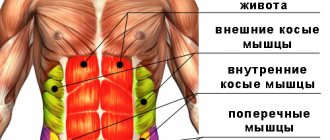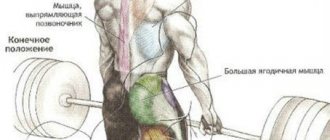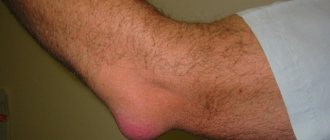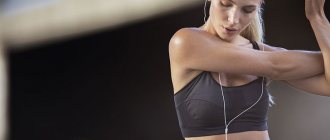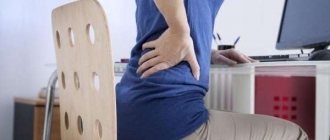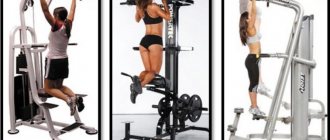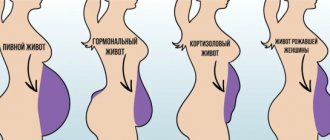Disproportional development of symmetrical muscles is a common problem. In professional sports, this phenomenon is called muscle imbalance, which refers to asymmetrical strength or volume of muscle mass on one side of the body in proportion to the other. Minor muscle asymmetry is typical for every person, and within certain limits this is a normal phenomenon. But it happens that the sizes can differ dramatically, and this is noticeable even to the naked eye. In order to eliminate such asymmetry, we must first understand its causes.
Reasons for asymmetry
1. Right-handedness/right-footedness and vice versa.
This is the most common reason, as everyone has it. I think there is no need to explain that there are right-handers and left-handers. And you all understand that if you, for example, are right-handed, then you make most of the movements in everyday life with your right hand. This means that by default it is more developed than the left one. That is, it is better coordinated, and the muscles on it are a little larger and stronger.
But this also applies to the legs. That is, in the same way there is left-footedness and right-footedness. Everyone has. The more active leg is also called the pushing leg, the less active leg is called the swing leg. Try a running jump forward. This is the foot you pushed off with - this is your push leg. Accordingly, your pushing leg will be larger and stronger than your swing leg.
2. Scoliosis
This is the second most common reason. It concerns mainly the asymmetry of the torso, that is, the chest, back and shoulders, and not the limbs. Scoliosis is a lateral curvature of the spine. Accordingly, if there is a curvature, then even if the muscles are the same size, they will look different. I have already written about how to correct scoliosis here.
3. Specific sports and activities.
Think about sports such as discus throwing, javelin throwing, shot put, for example. There the movement occurs mainly with one hand. Accordingly, in such athletes one arm and shoulder will be much more developed. Or, for example, long jumps, where the athlete always pushes off with only one leg. The same applies to specialties and types of work where movement occurs mostly with one hand or foot.
4. Different limb lengths
This is perhaps the rarest reason. If the length is different, then the place of muscle attachment is different. Therefore, even if the total muscle mass is the same, they can look different. But, in fact, it is quite rare for the difference in limb length to be any noticeable.
Treatment
What to do if signs of pathology become clearly visible? Most importantly, you need to contact a doctor who will determine individual treatment for the patient. And the methods of therapy will depend on the stage of the disease, as well as on the physiological characteristics of the human body (age, health status, presence of concomitant diseases, etc.)
Conservative therapy or surgery is used to treat scoliosis. The operation is indicated only for severe forms of pathology. It is important to remember that after surgery the patient will require a long recovery period. Moreover, there is a risk of complications - purulent fistulas, limb atrophy, disability.
Most often, patients are prescribed conservative therapy, including:
- therapeutic exercises;
- wearing a corset;
- massage;
- physiotherapy.
The above methods are not a complete list of therapeutic techniques that can be used for scoliosis. On the doctor’s recommendation, the patient may be prescribed kinesiotherapy, acupuncture, traction therapy, etc.
What asymmetry is acceptable?
I said above that the main and most common reason is right-handedness and right-footedness (and vice versa). He also said that because of this reason, everyone has asymmetry. Therefore, if the difference in arm volume does not exceed 10 mm, then this is considered normal. And the difference in the volume of the legs is no more than 15 mm. Personally, my left hand is 5 mm thicker than my right (I’m left-handed), and my right leg is as much as 20 mm thicker than my left. The fact is that not only is my left leg a swing leg, but the knee on it also hurts more than on the right. That's why there's such a difference.
This is how nature works
Strictly speaking, there should be no panic. The human body is designed in such a way that there is no clear symmetry in it. To make sure of this, just take the measuring tape that seamstresses use and carefully measure the muscles on the right and left sides of the body. Even an ideal athlete, in whom no difference is visually visible, will still have discrepancies in measurements. By the way, performing bodybuilders (professionals) very carefully monitor the proportions of their bodies and the problem of lagging muscles is very familiar to them. After all, modern bodybuilding, in some way, resembles a beauty contest, where, in addition to relief and volume, there must be ideal symmetry.
Sometimes the determination of body parameters is influenced by lighting and viewing angle. So ask your friend to look at you from a different vantage point. It is quite possible that all this just seemed to you and there is no need to worry about trifles.
How to remove muscle asymmetry?
Well, now we come to the main information in this article. There are 2 ways to remove or reduce muscle asymmetry with the help of training: the main method and the additional one.
1. Main method
Its essence is quite simple: During training, at the end of ALL exercises for the desired muscle group, you need to do 1–2 separate approaches on the lagging side.
That's all. The key phrase here is: at the end of all exercises. If, for example, you train only 1 muscle group per workout today, that means it will be at the end of the workout.
Why not do one set after each exercise, you ask? The fact is that the lagging side is lagging behind not only in size, but also in strength and strength endurance. Let's say you're training your biceps, and your left arm lags behind. After the first biceps exercise, you did one additional approach on your left arm. What happened in the end? Your left hand is more tired than your right. Then you move on to the second biceps exercise, and your left arm copes with this exercise even worse, since it is more tired than your right. And so on in increasing order. Therefore, additional approaches should be done AT THE END OF ALL EXERCISES for the desired muscle group.
Why only 1 - 2 approaches? Why can’t you do an additional 4 approaches, for example? You can do at least 10 and just rape your lagging side, BUT! Will the muscles on this side have time to recover after this? After all, if they do not have time to recover, then there will either be no result at all, or it will be exactly the opposite. Therefore, you just need to “add up” the lagging side a little, but do not overtrain it. And 1 – 2 additional approaches are quite enough for this purpose.
What exercises are suitable for training only one side?
Below I will give a list of such exercises. The list will not be complete, since you yourself can easily guess which exercises are suitable for this and which are not. I just want you to understand and see that there are quite a lot of such exercises. Let me draw your attention to the fact that the videos will be standard, and some of them will show the technique of performing simultaneously with both hands or feet. But don't let this confuse you, since the technique for performing only one side is usually exactly the same.
Biceps:
- Bend the arm while sitting over the knee
86,257
- Arm curl in the simulator
187,308
- Scott Bench Curl
101,312
Triceps:
- Arm extension from the upper block
- French press with dumbbell 1st hand
102,314
95,255
Legs:
- Single leg press in the machine
- Extension of one leg in the simulator
- Standing leg curl in the simulator
- Leg adduction in crossover
2,340
17,332
223,333
64,335
Buttocks:
- Lunges on one leg only
- Bulgarian single leg squats
- Hip extension in the simulator
- Leg abduction in crossover
- Crossover hip extension
- Swing your leg while lying on your side
62,289
254,1417
216,343
84,345
63,342
244,1206
Back:
- Bent-over dumbbell row
- One-handed lever pull
31,259
150,985
Breast:
- Bringing the arm from the upper block
- Bringing hands with rubber
107,297
344,1658
Shoulders:
- Swing your arm to the side from the lower block
- Swing dumbbells to the side while lying down
- Swing one arm forward
211,302
210,234
73,235
Let me emphasize once again that this list of exercises is not complete. I have given no more than half of the exercises that can be adapted to one side. Or even less. The repetition range should be from 8 to 15.
2. Additional method
For those exercises where the movement is done first with one arm or leg, always start with the weak arm or leg.
For example, the same Bulgarian squats or arm swings to the side from the lower block. The fact is that almost all people intuitively start, on the contrary, from the stronger side. It's just easier, but it's wrong. ALWAYS start on the weaker side as you have more strength (both physical and emotional) at the beginning of the set. And let this greater amount of strength go to the weaker side. This method is additional only because we, as a rule, do most of the exercises in training with both arms or legs at the same time.
Chest deformation - causes
Poland syndrome
Poland syndrome
is a disorder where a baby is born with missing or underdeveloped muscles on one side of the body. The syndrome usually occurs on the right side of the body and is more common in boys than girls. A baby born with Poland syndrome may have an underdeveloped chest, resulting in chest asymmetry.
A person with Poland syndrome may have the following symptoms:
- missing pectoral muscles
- unusually short or webbed fingers
- lack of hair in the armpits
- underdeveloped skin and fatty tissue on the affected side
- underdeveloped nipple tissue
- underdeveloped bones in the shoulder or arm
A teenager going through puberty may notice lopsided growth as the first sign of Poland syndrome.
Treatment
Patients with minor signs of the syndrome do not require treatment. However, severe cases of Poland syndrome may require reconstructive surgery.
Surgery involves reconstructing the missing pectoral muscles using existing muscles. The surgeon may use a rib graft to replace missing ribs.
A patient who requires surgery must wait until he reaches puberty. Early surgical intervention may lead to increased chest asymmetry.
Women with Poland syndrome should wait until their breasts have fully developed before having reconstructive surgery. This ensures that the reconstructed breast is symmetrical to the other.
Scoliosis
Scoliosis is a condition that results in curvature of the spine. Scoliosis can affect any side of the body and creates the appearance of an uneven ribcage. Although a person of any age can develop scoliosis, it is most common in women and children over 11 years of age.
Symptoms of scoliosis
- sloping shoulders with one prominent shoulder blade
- uneven back
- ribs more convex on one side than the other
- pelvic distortion
- spinal cord problems causing numbness, weakness, and loss of coordination
Treatment
Treatment for scoliosis may depend on the following factors:
- person's age
- stage of development
- severity of spinal curvature
Children with scoliosis will need to see a doctor every 4-6 months. The doctor will monitor the development of scoliosis. Sometimes a child's scoliosis improves or goes away on its own.
Other treatments include:
Wearing a corset
If scoliosis gets worse, your doctor may recommend wearing a corrective corset. By wearing it for 16 hours a day, the need for surgery may be reduced. A corrective corset is worn under clothing, and a person can take it off when taking a shower.
Gypsum bandage
Plaster casting involves covering a person's chest with a plaster cast. Every 6 months a healthcare professional will change the cast. Although a cast does a good job of aligning the spine, it can be uncomfortable.
Surgical treatment
If the curvature of the spine progresses, surgery may be required.
Exercise and massage
Massage, Pilates, and yoga can help relieve pain in a person with scoliosis.
However, these methods cannot prevent the exacerbation of scoliosis.
Cervical ribs
Cervical ribs
- these are non-functioning ribs, most often found as paired formations at the VII cervical vertebra. Most cervical ribs remain unnoticed throughout a person's life. However, they may appear as a hard lump near the collarbone. Cervical ribs can occur on any side of the body, but are more common on the left side. In rare cases, cervical ribs can compress surrounding blood vessels, causing numbness and tingling in the arm. In addition to X-ray examination methods, cervical ribs can be detected using ultrasound.
Treatment
Although a person with cervical ribs usually does not experience any symptoms, if complications occur, surgery is performed to remove the rib.
Funnel deformity
Pectus excavatum is a condition in which the chest changes its shape, volume and size, which is manifested by a decrease in the sternovertebral distance and flattening of the chest itself.
It is difficult for doctors to diagnose pectus excavatum from birth because symptoms usually do not appear until early childhood or adolescence.
People with pectus excavatum may experience the following symptoms:
- shortness of breath on exertion
- chest pain
- weakness
- tachycardia, in which the heart beats more than 100 times per minute
- wheezing during exercise
- asthma or upper respiratory tract infection
- fainting or dizziness
- unpleasant feeling in the stomach
Pectus excavatum is more common in men than in women.
Treatment
Anti-inflammatory medications, exercise therapy, and acupuncture may help treat pain in a patient with pectus excavatum. But it is preferable to have corrective surgery during adolescence. According to a 2017 review, surgery can improve cardiopulmonary function, improve self-esteem, and reduce associated symptoms.
Keeled chest
Pectus carinatum, or pectus carinatum, is characterized by protrusion of the sternum forward. This condition can give the chest an uneven appearance.
Boys are four times more likely to have a keeled chest than girls.
Pectus carinatum can occur on both sides, but is more likely to appear on the right side. People with keeled chest have no symptoms, although they may sometimes experience:
- shortness of breath
- abnormally fast breathing during exercise
- reduced stamina
Treatment
Corrective braces are a treatment option for pectus carinatum. However, a person will need to wear braces 14-24 hours a day. They also become less effective once a person turns 19.
Given that pectus carinatum often does not cause any symptoms, surgery is usually cosmetic. Some people engage in bodybuilding to minimize sternum protrusion.
Method not working
At the end of the article I would like to touch on one way to eliminate asymmetry, which, in my opinion, does not work at all, but which for some reason is recommended by many trainers and bloggers. And this is what they advise:
Place more weight on the lagging side.
For example, if your left arm lags behind, and you do curls with dumbbells, then take an 18 kg dumbbell in your right hand, for example, and a 20 kg dumbbell in your left hand. That is, these people advise you to take more weight on the weaker side! Well, how does your weaker hand lift a dumbbell that is heavier than in your stronger hand? No way! More precisely, it will lift, but if with your right hand you lift 18 kg 12 times, then with your left hand – 20 kg 6 times. And if it’s more, then with such a clumsy technique, which will be of little use. Well, the question is, why did everyone suddenly decide that this method would work? It won't work.
Level 3: Select exercises for other muscles
A very effective (but rarely used) way to challenge a stubborn group is to select exercises for other muscles so that they are forced to engage.
Replacement examples:
Biceps are lagging behind - do more rows with a supinated grip, train your legs with a Zercher or goblet squat, for traps try cable shrugs or Kirk shrugs, for physical fitness/cardio work on a rowing machine, etc.
The triceps are lagging behind - when training your chest and deltas, instead of isolating, do more pressing movements, try a narrower grip on all presses (not to the point of touching the hands, just a normal one), add a pullover or block row with straight arms to your back training, work your trapezius with shrugs with the barbell overhead and so on.
The deltoids lag behind - when training your chest, press more on an incline bench (head up), for your back, more horizontal rows, also pump your biceps on an incline bench, work your triceps with push-ups on the parallel bars and bench press with a narrow grip, for your legs, try goblet squats with a high number of repetitions and etc.
The calves are lagging behind - perform more exercises while standing on your own two feet, add farmer's walks or sled pushing for general physical training, pump up the deltoids with a push press ("shvung press"), and for the back try simplified TA movements, for example, lifting the barbell on the chest in a half squat (" in a rack"), etc.
The glutes and hamstrings are lagging behind - try deadlifts with an emphasis on the upper back, add simplified versions of TA movements or snatch/jerk deadlifts, hyperextensions, more sled pushing for general physical training, etc.
Quadriceps are lagging behind - choose deadlifts with more load on the legs, push presses for deltoids, sled pushing for general physical training, more standing exercises, etc.
The traps are lagging behind - work your legs with a Zercher squat or goblet squat, multi-repetition lunges and deadlifts with a trap bar, for your back do the Romanian deadlift and Zercher tilt, do standing biceps curls, standing overhead extensions for triceps, increase the range in side raises for deltoids ( lifting dumbbells above your shoulders), etc.
